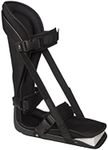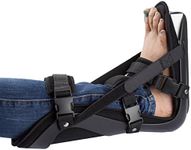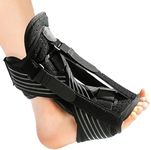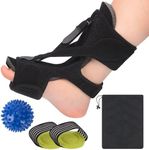Buying Guide for the Best Plantar Fasciitis Night Splints
Plantar fasciitis night splints are designed to provide relief and aid in the healing process for those suffering from plantar fasciitis. These splints work by keeping the foot in a dorsiflexed position, which stretches the plantar fascia and Achilles tendon during sleep. This helps to reduce pain and inflammation, and promotes healing. When choosing a night splint, it's important to consider several key specifications to ensure you select the best fit for your needs.Type of SplintThere are two main types of night splints: dorsal and boot-style. Dorsal splints are lighter and less bulky, making them more comfortable for some users. They fit on the top of the foot and are generally easier to put on and take off. Boot-style splints, on the other hand, provide more support and are often more effective for severe cases of plantar fasciitis. They encase the foot and lower leg, offering a more comprehensive stretch. Choose a dorsal splint if you prioritize comfort and ease of use, and a boot-style splint if you need maximum support and effectiveness.
AdjustabilityAdjustability refers to the ability to customize the fit and angle of the splint. This is important because it allows you to find the most comfortable and effective position for your foot. Some splints offer adjustable straps and tension settings, which can help you gradually increase the stretch as your condition improves. Look for a splint with multiple adjustment options if you want a personalized fit and the ability to modify the stretch over time.
ComfortComfort is crucial when wearing a night splint, as you will be sleeping with it on. Features that enhance comfort include padded straps, breathable materials, and a lightweight design. A comfortable splint will be easier to wear consistently, which is important for effective treatment. If you have sensitive skin or are prone to discomfort, prioritize splints with extra padding and soft, breathable fabrics.
Size and FitSize and fit are important to ensure the splint stays in place and provides the necessary support. Splints typically come in various sizes, and some are adjustable to fit a range of foot sizes. It's important to measure your foot and refer to the manufacturer's sizing guide to select the correct size. A well-fitting splint will be more effective and comfortable, so take the time to find the right size for your foot.
Ease of UseEase of use refers to how simple it is to put on, adjust, and take off the splint. This is important because you will be using the splint daily, and a complicated design can be frustrating and discourage consistent use. Look for splints with clear instructions, easy-to-use straps, and minimal components. If you have limited mobility or dexterity, prioritize splints that are straightforward and quick to put on and remove.
DurabilityDurability refers to how well the splint holds up over time with regular use. A durable splint will maintain its shape and effectiveness, providing consistent support throughout your treatment. Consider the materials and construction of the splint, and look for reviews or information on the longevity of the product. If you plan to use the splint for an extended period, invest in a high-quality, durable option.













